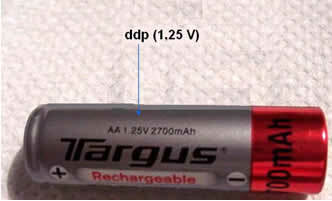Consider two batteries surrounding the copper electrode:

Zinc-copper and copper-silver batteries.
In the first cell, known as the Daniell cell, the electrodes are made of zinc and copper and we notice that the zinc undergoes oxidation, that is, it donates electrons to the copper, being, therefore, the anode. The copper electrode, in turn, works like the cathode, receiving electrons and reducing itself.
However, it is possible to observe that in the second pile, the copper-silver electrodes, the copper works not as a cathode, but as an anode, oxidizing this time.
This shows us that comparing these three electrodes, the tendency to suffer reduction works as follows:
| Zinc < Copper < Silver |
Thus, this ability to undergo reduction is called Reduction Potential (Ered). Since this value depends on the pressure, temperature and concentration of the solution, a standard potential (or normal, at 25°C, pressure of 1atm, and concentration of 1.0 mol/L) which is identified by the symbol AND0. The opposite is also true, there is the Oxidation Potential (Eoxy), which in this case has ascending order:
| Zinc > Copper > Silver |
The lower the standard reduction potential, the greater the metal's ability to donate electrons and vice versa. Similarly, the lower the standard oxidation potential, the greater the metal's ability to receive electrons and vice versa.
| In a pile, the species with the highest Ered undergoes reduction and the other species, with the highest Eoxy, undergoes oxidation. |
If we adapt a voltmeter, like the one in the figure above, to one of these cells, the intensity of the electric current produced by them will be measured, that is, its electromotive force (emf or E) or potential difference (U or ddp)*. The value is indicated in volts (V), normally appearing on battery packs and labels.

Potential difference (U or ddp) of a battery shown on the label.
Electromotive force can be expressed in terms of reduction or oxidation potential. It is important to remember that these potentials have the same value but have opposite signs.
To calculate the voltage of a battery in the standard state, we use the following expression:
| ∆And0 = AND0red (cathode) - AND0red (anode) |
or
| ∆And0 = AND0oxy (anode) - AND0oxy (cathode) |
Thus, the absolute values of each electrode do not appear on the voltmeter, but the potential difference between them.
*We consider the potential difference equal to the electromotive force, because the calculation of the potential difference of a generator is given by the equation: U = E – r.i, where:
U = potential difference
E = electromotive force
r = internal resistance
i= electric current intensity
But, in Chemistry, we consider batteries as ideal generators, so that their internal resistance is negligible in relation to the electrical circuit. So we have that U = E.
Source: Brazil School - https://brasilescola.uol.com.br/quimica/diferenca-potencial-uma-pilha.htm



